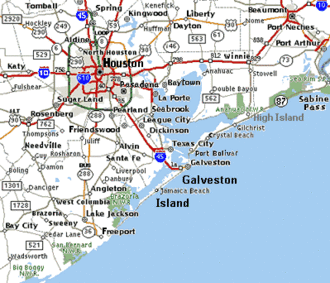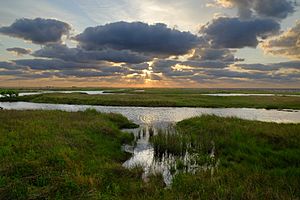Sea Rim State Park facts for kids

Sea Rim State Park is a special place in southeast Texas. It's a large state park that covers about 4,141 acres (1,676 hectares). This park is found right on the coast of the Gulf of Mexico in southern Jefferson County. It's located south of Port Arthur and just west of Sabine Pass.
The park had to close for several years because of a lot of damage from big storms called Hurricanes Rita (in 2005) and Ike (in 2008). Luckily, the park has now re-opened! While it's still getting back to normal, visitors can enjoy many of its natural wonders.
Contents
Exploring Sea Rim State Park's Areas
Sea Rim State Park has two main parts that offer different kinds of adventures: the D. Roy Harrington Beach unit and the Marshlands unit. Each area lets you experience a unique part of the Texas coast.
The Beach Unit: Sand and Waves
The D. Roy Harrington Beach unit is the part of the park right on the Gulf of Mexico. This area gives you direct access to the sandy beach, where the ocean meets the land. It's a great spot for enjoying the sun and the sound of the waves.
You can swim in the Gulf waters here. However, it's important to remember that swimming is not allowed in the marsh areas. This is because alligators live in the marshes, and it's safer to stay out of their habitat.
The Marshlands Unit: Hidden Wetlands
The Marshlands unit is located inland, deep within the marshes of southern Jefferson County. This part of the park is very different from the beach. You can only reach the Marshlands unit by boat.
The park makes it easy to explore these hidden areas by renting out canoes and kayaks. Paddling through the marshes is a fantastic way to see nature up close.
Birdwatching in the Marshes
The Marshlands unit is a paradise for bird watchers. Many different kinds of migratory birds stop here during their long journeys. The park has special spots called observation blinds. These are like hidden shelters that help you watch birds without disturbing them. You can see many beautiful and rare birds in their natural home.
Nearby Wildlife Refuges
Sea Rim State Park is part of a bigger natural area. It shares a border with the McFaddin National Wildlife Refuge. This refuge helps protect even more wildlife and their homes.
There are also three other important national wildlife refuges nearby on the Texas coast. These are Brazoria N.W.R., San Bernard, and Big Boggy. Together, these places create a huge network of coastal wetlands. These wetlands are super important because they provide a safe home for more than 300 different kinds of birds!
History of Sea Rim State Park
Sea Rim State Park has an interesting history, including how it was created and how it has faced challenges from nature.
Park's Beginning
The land that became Sea Rim State Park was bought in 1972 from two companies, the Planet Oil and Mineral Corporation and Horizon Sales Corporation. After a few years of preparation, the park officially opened to the public in 1977.
Impact of Hurricanes
The Texas coast can experience strong storms, and Sea Rim State Park has been affected by them.
Highway Changes
A part of Texas State Highway 87 used to run through Sea Rim State Park all the way to High Island. However, this section of the highway is now closed. It was destroyed in 1989 by Hurricane Jerry. Before that, earlier storms had already worn away the beach. This made the highway very weak and easy for the storm's powerful waves to wash away.
Park Closures and Reopening
In September 2005, Hurricane Rita caused a lot of damage to Sea Rim State Park. This forced the park to close its doors. Then, in 2008, Hurricane Ike hit and caused even more damage.
After these big storms, the park slowly began to recover. In April 2010, it re-opened for limited use during the daytime. By June 2014, the Texas Parks and Wildlife Department (TPWD) had worked hard to bring back many services at the park.
Today, the park offers water and electric services for campsites that are located off the beach. Visitors also have the option to camp right on the beach in more basic, "primitive" campsites. You can find more detailed information about visiting the park on the Texas Parks and Wildlife Division website.


